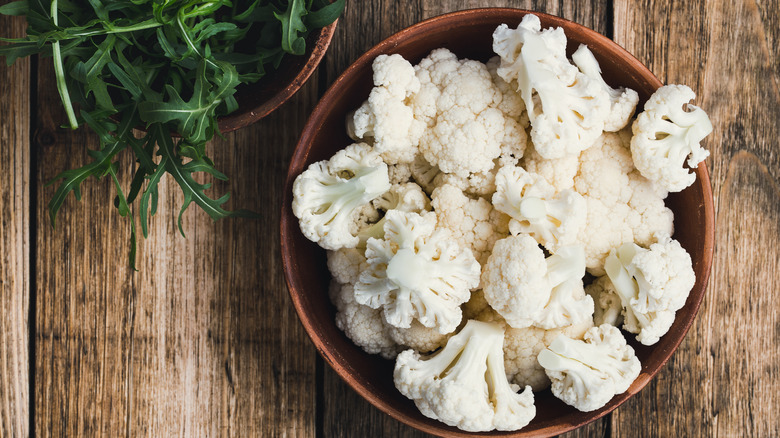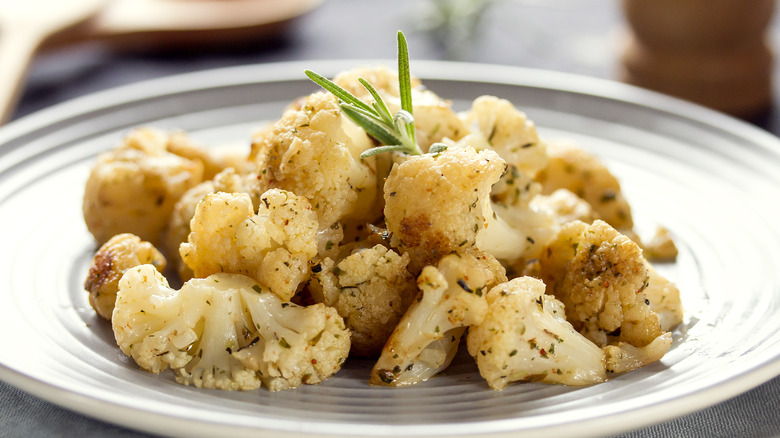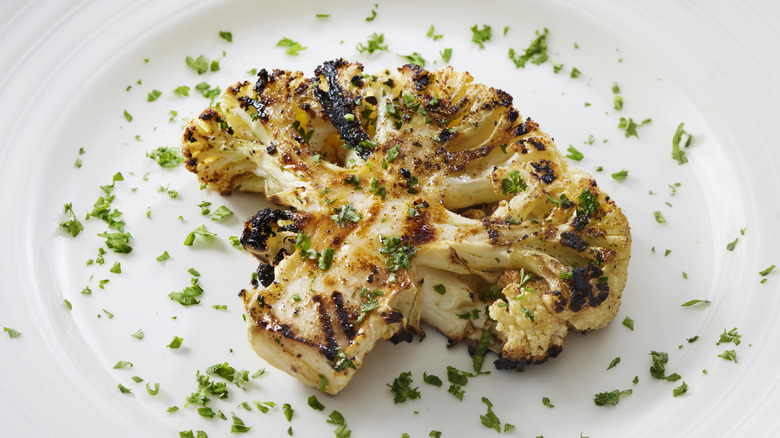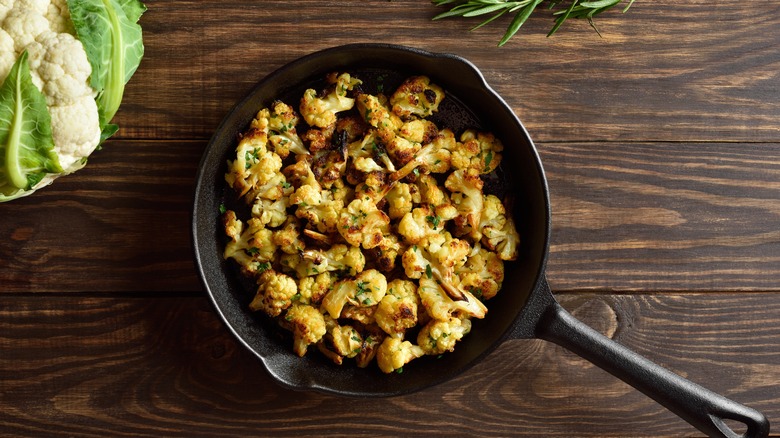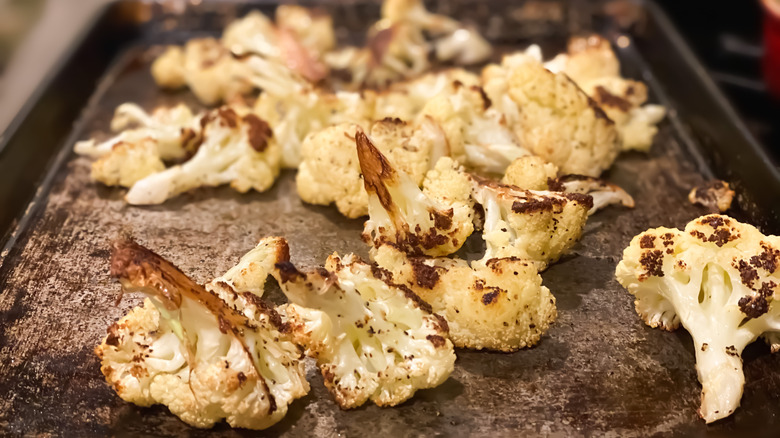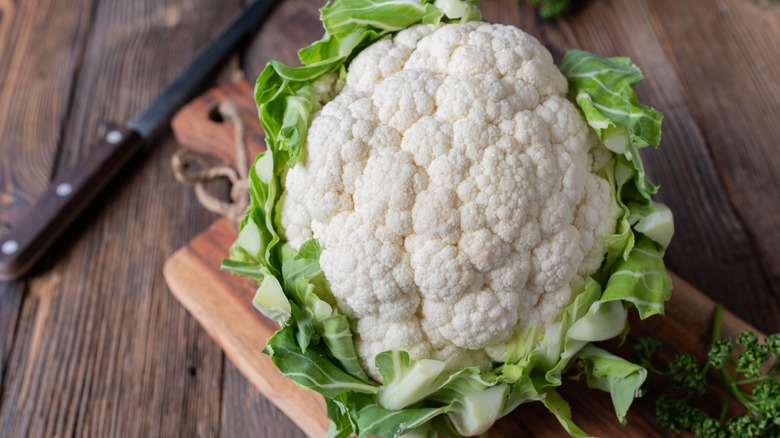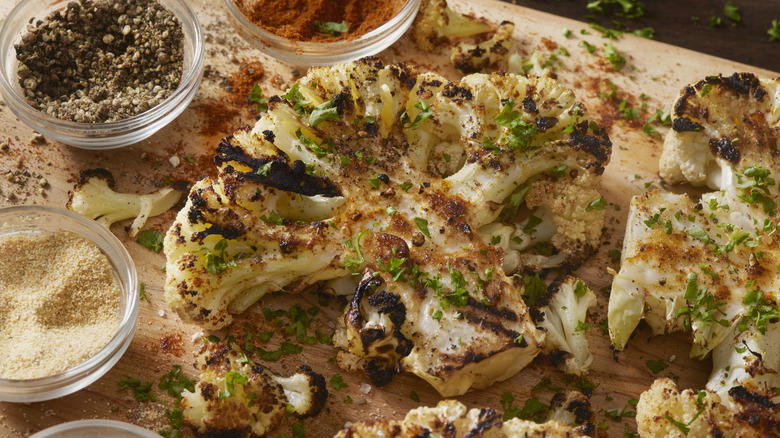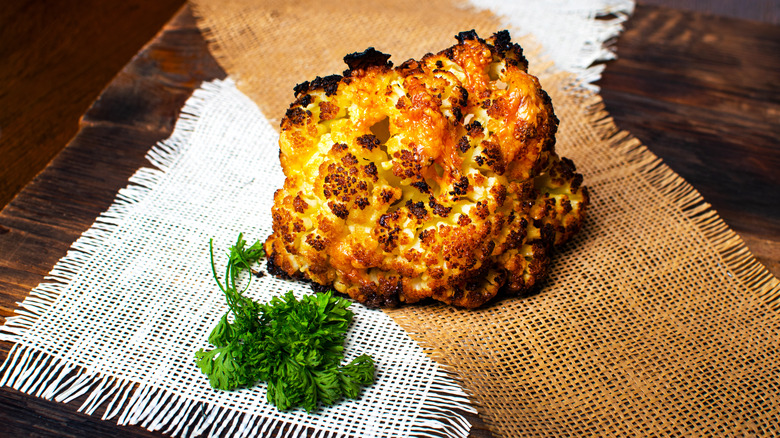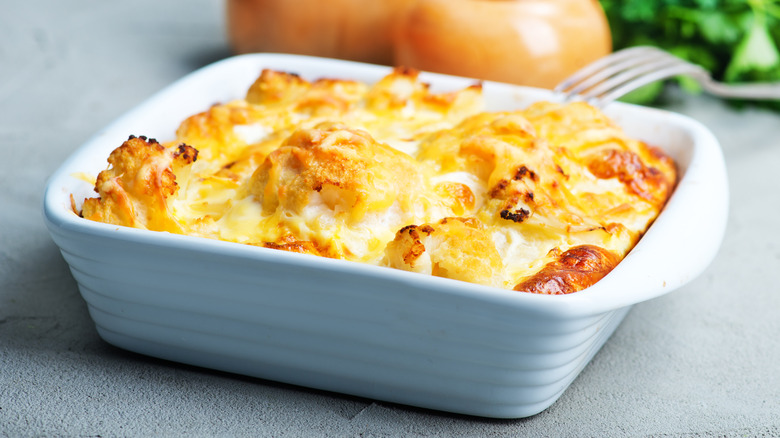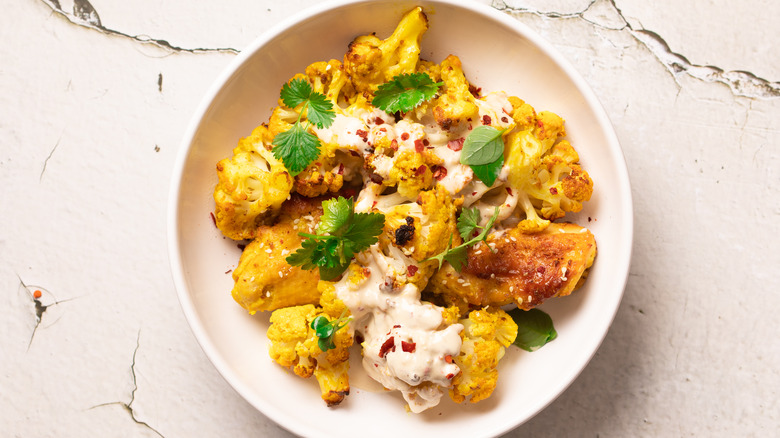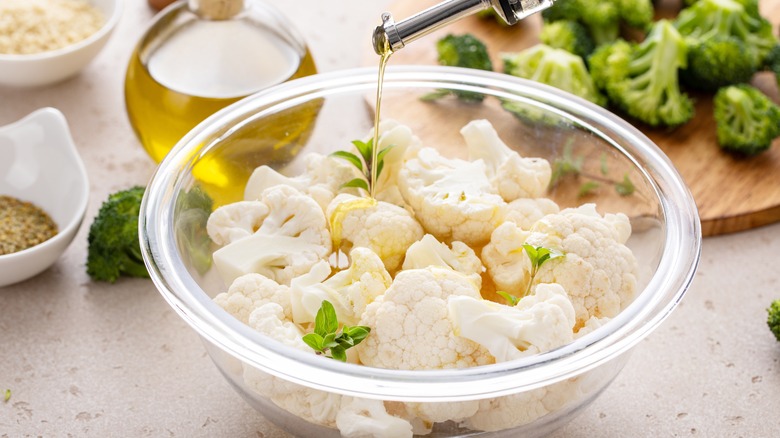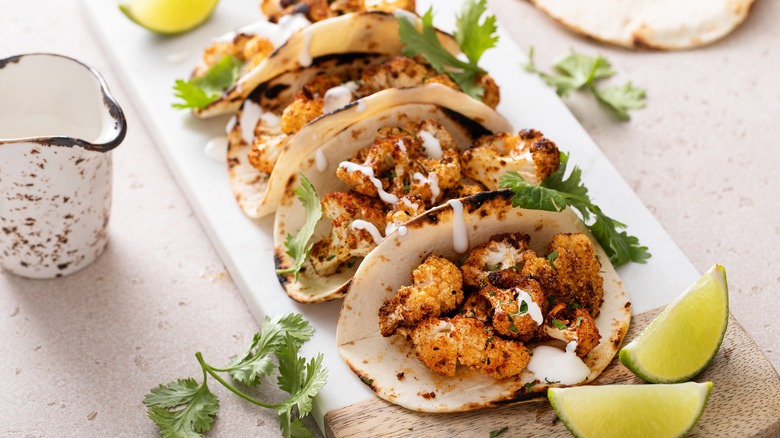11 Mistakes Chefs Say Everyone Makes With Cauliflower
We may receive a commission on purchases made from links.
Cauliflower might not seem like a complicated thing to cook, but there are mistakes everyone makes with it. In the wrong hands, cauliflower can come out tasteless and mushy or crunchy and undercooked. Perhaps you believe you know everything there is to know about cauliflower but you might not realize you can boost its flavor by roasting it. Or, when you do decide to roast it, you might crowd the pan, steaming it and leaving it pale rather than beautifully browned and flavorful. So, there are more potential pitfalls than you might imagine.
As an experienced food writer and recipe developer, cooking cauliflower isn't a mystery to me. I know where folks commonly go wrong and have some handy workarounds. But, don't just take my word for it. I interviewed five experts for this piece, including professional chefs and food bloggers, to learn about common missteps home cooks make with this cruciferous veggie.
We uncovered the mistakes chefs say everyone makes with cauliflower. We're not just going to discuss the errors, but also point out how to fix them or avoid them. Armed with this info, you can greatly improve how you cook it. Whether you're eating it as a simple side or the main event, cauliflower will never be bland or boring again in your hands.
1. Overcooking or undercooking
Yes, it's a basic error, but undercooking or overcooking cauliflower is a hugely common mistake. In fact, if you know someone who says they don't like cauliflower, this is often the reason why. It isn't really that they dislike it, but rather they've only eaten bad examples of it.
First, let's look at what happens if you cook this veggie too long or not long enough. "Overcooking cauliflower can release gasses and make the vegetable mushy," says Olivia Roszkowski, chef-instructor of Plant-Based Culinary Arts at the Institute of Culinary Education. "As cauliflower cooks, it tends to release more and more sulfurous compounds," she notes, explaining that this can cause a strong odor.
But, undercooking cauliflower isn't the answer. "Undercooked cauliflower can be tough and dry and it won't have the sweet flavor that you can get from cooking it a bit longer," Maggie Turansky of No Frills Kitchen remarks.
So, the answer is to find that balance between the two extremes. However, it's not always simple because different cauliflower cooking methods take different lengths of time. For instance, if you follow a roasted cauliflower recipe, the cook time will be far longer than if you steam your cauliflower. One way is to regularly check your cauliflower and look for the signs that it's ready. "When it's done well, it's perfectly fork-tender with a nutty flavor," recipe developer and cookbook author Jeanine Donofrio of Love and Lemons tells us.
2. Under-seasoning
There are various ways to upgrade cauliflower. One of them is simply seasoning it properly. But, you'd be amazed how many people under-season cauliflower. If you've often thought of this vegetable as bland, it's probably just that you haven't been seasoning it right. Thankfully, this is easy to rectify.
"Cauliflower can sometimes be bland if not seasoned properly," remarks Joanne Gallagher, recipe developer and co-founder of Inspired Taste. "I'm pretty generous with my salt and pepper, which helps to season and bring out its natural flavor." So, even just a nice quality sea salt can make all the difference. Knowing how to use enough salt without using too much can take some trial and error, but it's something you'll work out over time.
But, that's not where the seasoning options stop — you can add all kinds of herbs and spices. "Since cauliflower has such a neutral flavor, you can be bold with your favorite herbs and spices like garlic powder, smoked paprika, or even a pinch of cayenne for a little kick," Gallagher suggests.
Marinating cauliflower before roasting or sautéing it is another great way to add flavor. "My favorite way to serve cauliflower is with a hoisin marinade for a delicious twist," says Dale Talde, a cookbook author, "Top Chef" contestant, and chef and owner of Goosefeather in New York. "Simply mix hoisin, soy sauce, a touch of honey, and five spice." He adds that you can also use sriracha for some heat.
3. Not roasting or sautéing it
If you're not roasting or sautéing your cauliflower, you're missing out. Sure, you can steam and boil cauliflower, but you won't get the same depth of flavor. It's a mistake many people make with cauliflower, resulting in them thinking this vegetable is inherently bland.
"Roasting and sautéing cauliflower is almost always a crowd pleaser because they develop sweet, nutty notes and less odorous compounds," remarks chef and cooking instructor Olivia Roszkowski. Food blogger and recipe developer Joanne Gallagher agrees that both roasting and sautéing are great cooking methods for this veggie. "Roasting is a favorite because it caramelizes the edges and creates a delicious nutty flavor," she says. She also likes sautéing, especially when short on time. "It quickly browns the cauliflower, giving it a lovely texture and taste," she explains.
Some people also like to make "cauliflower rice" by chopping florets into tiny pieces using a food processor before cooking it. Recipe developer Jeanine Donofrio likes to sauté her cauliflower rice. "It's a quick and easy way to warm the cauliflower rice and help it absorb flavor from seasonings like salt, pepper, and lime," she tells us.
4. Crowding the pan when roasting
You might have jumped aboard the roasting train, but if you crowd the baking pan, you might as well have saved yourself some time and just steamed it on the stove top. When you put too much cauliflower in the pan, it affects the way it cooks. You won't get that delicious browning and toasty, nutty flavor that roasting usually brings.
"Sometimes, the florets end up steaming instead of roasting because the moisture released from the cauliflower has nowhere to go, so it stays trapped around the veggies," explains Joanne Gallagher of Inspired Taste. "As a result, you miss out on that lovely caramelization and those crispy, golden edges that make roasted cauliflower so delicious." You could put your cauliflower in the oven for 30 to 40 minutes and expect golden deliciousness, but instead end up with a soggy mess. And nobody needs that disappointment.
Olivia Roszkowski, a chef-instructor at the Institute of Culinary Education also warns us against overcrowding. "When you crowd the pan, steaming occurs, herbs and spices cannot toast, the temperature cannot rise, and the result is uneven cooking," she tells us. "The Maillard reaction cannot occur at lower temperatures when moisture is present so flavor development is weakened."
The solution is simple, though. Instead of cramming as much cauliflower as you can into one tray, space it out into a single layer with a little bit of room around each piece. If this means you have to use an extra pan and do more dishes, so be it.
5. Throwing away the greens
Perhaps the biggest mistake you're making with cauliflower is throwing away the greens. Most of us assume these big leaves are inedible, so we cut them away from the cauliflower and put them in the trash. In actual fact, you could be using them, so you get more bang for your buck with each cauliflower and do your bit for reducing food waste.
"When I make roasted cauliflower, I love to roast the cauliflower leaves alongside the florets," Jeanine Donofrio of Love and Lemons tells us. Chef Olivia Roszkowski suggests that you "throw them into a stir-fry, cut thin and massage, add to soups, fried rice, or roast into chips." However, she says you should "only use cauliflower greens if they are still a vibrant green and appear appetizing." Avoid adding them to anything with a long simmering time because they can release strong, sulphureous compounds that overtake the resulting dish.
According to chef Dale Talde, another option is to pickle cauliflower leaves. "Simply mix rice wine vinegar, sugar, soy sauce, and sriracha chili sauce," he suggests. "Then, soak the leaves for as long as you want." You should let them sit in the pickling liquid for at least an hour, but the longer the better. You can let them sit and marinate in the fridge for as long as a week.
6. Not charring it a little for flavor
People are often scared to take the color of their cauliflower too far when roasting it. They assume that a little bit of browning is good, but anything more than that means their cauliflower is just burned. However, that's not necessarily the case. Sure, you don't want to roast it to a crispy cinder, but a little bit of charring is great.
Recipe developer Maggie Turansky recommends that you "roast the florets in a ... 425 degrees Fahrenheit oven and don't be afraid if they start to char a bit — this is where you'll get a lot of flavor." So, if you've got some blackened parts on your roasted florets, don't worry about it. This just means you've succeeded in getting a nice char. It's only going to boost the taste of your finished dish. Turansky talks about roasting cauliflower, but the same goes for sautéing it — a little char goes a long way to tastier veggies.
7. Cooking it just once
Most people cook their cauliflower just once, whether boiling, steaming, roasting, or any other method of your choice. But, you can double-cook it for even better results. Yes, it takes extra time and effort, but if you're wondering why your cauliflower is never as good as you want it to be, this might be worth a shot.
"Don't be afraid to cook it twice, such as by microwaving and steaming, then roasting, grilling or searing like a steak," says Goosefeather chef Dale Talde. "It does wonders and helps the vegetable absorb flavors better." So, this could be your key to even tastier cauliflower. Seasoning it well after the first stage of cooking ensures a flavorful finished dish. Some people even cook a whole cauliflower in this way. You first blanch the cauliflower, then cover it in sauce and roast it whole. Not only is this delicious, it's also a great vegetable centerpiece if you want an impressive vegetarian or vegan meal.
If you're finding your cauliflower isn't soft enough for your liking, this is another reason to double-cook it. "To make sure you are thoroughly cooking it, I'd recommend first steaming it or even putting it in the microwave to soften, then slowly roasting it over the fire to achieve a nice char and texture," Talde tells us. Of course, if you're not down for cooking with fire (such as on a grill), you could broil, roast, or even cook it over a gas flame for the second stage.
8. Ignoring the beauty of cauliflower cheese
Cauliflower cheese is a British classic, but it hasn't made it across the pond as reliably — and this is a shame. Ignoring the option to smother your cauliflower in cheese sauce and bake it is obviously a mistake. So, if you haven't already, it's time to get in on this delicious dish.
"Cauliflower cheese is an excellent way to use this vegetable and it's often a highlight for me during a classic British Sunday roast," says food blogger Maggie Turansky. "A creamy, cheesy sauce pairs perfectly with tender cauliflower and can create a comforting and delicious dish that's hard to resist," remarks Joanne Gallagher of Inspired Taste. "It's also easy to customize — add a sprinkle of breadcrumbs on top for some crunch or mix in other veggies, like broccoli, for extra nutrition," she adds.
But, cauliflower cheese isn't your only option if you want to enjoy this veggie in a creamy sauce. "I have a recipe for a cauliflower gratin in my second cookbook, which features a creamy sauce made from blended cauliflower, cashews, and miso paste," cookbook author and food blogger Jeanine Donofrio tells us. She also makes a creamy cauliflower in a vegan cheese sauce that's made out of sweet potatoes and nutritional yeast. Chef Olivia Roszkowski suggests some other creamy sauce options, including coconut curry, béchamel, smoked cashew cream, and Parmesan cream sauce.
9. Serving it without a sauce or dressing
We've talked about sauces that you might bake your cauliflower in, but you can also add sauces and dressings after cooking. It's such a simple way to boost flavor in a meal, so going without sauces is a rookie error. Luckily, there are all kinds of sauces that cauliflower pairs beautifully with, so it shouldn't be an issue to find one that you love.
"Muhammara, yogurt sauce, tahini sauce, warm golden raisin vinaigrette, pesto, miso ginger dressing, green goddess dressing, romesco, honey mustard, toum (a Lebanese garlic sauce), and chimichurri all go great with cauliflower," says chef and Institute of Culinary Education instructor Olivia Roszkowski. Recipe developer Maggie Turansky is another fan of tahini sauce with cauliflower. "Simply add some tahini to a bowl along with a bit of lemon juice, garlic, salt, and pepper," she instructs. "Thin it out with some water and drizzle it over some roasted florets — it is absolutely delicious."
Food blogger Joanne Gallagher suggests that, to liven up cauliflower, you need zippy sauces made with lemon, lime, or vinegar. However, she also likes creamy and buttery sauces. "If you want something fancy, but still easy, cook some sage leaves in brown butter, and pour it over your roasted cauliflower," she says. Chef Dale Talde says that sauces or dressings that use toasted sesame oil are a good call. "When roasted properly, cauliflower has a nutty taste to it and sesame oil is a wonderful way to enhance this natural flavor," he notes.
10. Using too little oil when roasting or sautéing
When you're roasting or sautéing cauliflower, you need oil. However, many people make the mistake of not using enough. This can stop the cauliflower from cooking properly. It may end up drying out before you cook it through. Or, the lack of oil can cause it to steam, rather than roast or fry, so it won't get that flavorful browning.
Maggie Turansky of No Frills Kitchen believes that roasting cauliflower is one of the best ways of cooking it, but that most home cooks don't use nearly enough oil. "For the florets of a medium-sized head of cauliflower, I like to toss it in at least ¼ cup of olive oil," she tells us.
Chef Olivia Roszkowski agrees that oil is important when cooking cauliflower, noting that "tossing the veg well in olive oil before baking" is essential. She explains that this is part of what lets the cauliflower "reach a higher temperature more quickly, allowing it to caramelize and become sweeter and nuttier in taste."
Olive oil is a go-to for many chefs when roasting or sautéing cauliflower. However, you can use any oil of your choosing. For instance, if you want a more neutral taste, you could use canola oil. Or, unrefined coconut oil is a good choice if you want a rich coconut flavor that might go with a Thai curry, for instance.
11. Not making the most of its versatility
Cauliflower is hugely versatile. Not making the most of that fact is a mistake. It can be tough to know where to start, though. Exploring a range of cauliflower recipes is a logical jumping off point. You could also think about other recipes in your repertoire where you could switch cauliflower for another vegetable.
"One common mistake people often make when serving cauliflower is not taking advantage of its versatility," says recipe developer Joanne Gallagher. Although people often relegate it to a side dish, she says that it can be used in so many ways other than that. "Try using cauliflower as a rice substitute, in soups, as a salad topper, and even as a pizza crust," Gallagher suggests. "You can even make cauliflower steaks, which is one of my favorites," she adds.
Thinking of great flavor combinations for your cauliflower can also help you branch out. "I love cauliflower with lots of lemon zest and fresh parsley," notes Jeanine Donofrio of Love and Lemons. "And in my whole roasted cauliflower recipe, I prepare it with a bold, earthy blend of harissa, smoked paprika, cumin, and thyme." Olivia Roszkowski also shares some amazing flavor combinations to try with cauliflower, such as brown butter and sage, preserved lemons, and crispy shallots and chili crunch.
